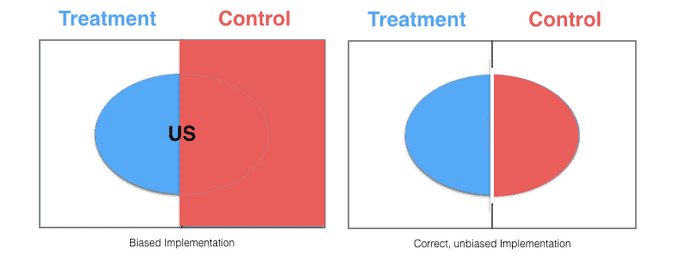Must-Know: Key issues and problems with A/B testing
A look at 2 topics in A/B testing: Ensuring that bucket assignment is truly random, and conducting an A/B test on an opt-in feature.
Editor's note: This post was originally included as an answer to a question posed in our 17 More Must-Know Data Science Interview Questions and Answers series earlier this year. The answer was thorough enough that it was deemed to deserve its own dedicated post.
Topic #1: Ensuring that bucket assignment is truly random
First, let’s consider how we can best ensure comparability between buckets prior to bucket assignment, without knowledge of any distribution of attributes in the population.
The answer here is simple: random selection and bucket assignment. Random selection and assignment to buckets without regard to any attribute of the population is a statistically sound approach, given a large enough population to draw from.
For example, let’s say you are testing a change to a website feature and are interested in response from only a particular region, the US. By first splitting into 2 groups (control and treatment) without regard to user region (and given a large enough population size), assignment of US visitors should be split between these groups. From these 2 buckets, visitor attributes can then be inspected for the purposes of testing, such as:
if (region == "US" && bucket == "treatment"):
# do something treatment-related here
else:
if (region == "US" && bucket == "control"):
# do something control-related here
else:
# catch-all for non-US (and not relevant to testing scenario)

Image Source.
Bear in mind that, even after performing a round of random bucket assignment, statistical testing can be utilized to inspect/verify random distribution of bucket member attributes (e.g. ensure that significantly more US visitors did not get assigned to bucket A). If not, a new random assignment can be attempted (with a similar inspection/verification process), or -- if it is determined that the population does not conform to a cooperative distribution -- an approach such as the following can be pursued.
If we happen to know of some uneven population attribute distribution prior to bucket assignment, stratified random sampling may be helpful in ensuring more evenly distributed sampling. Such a strategy can help eliminate selection bias, which is the archenemy of A/B testing.
References:
- Detecting and avoiding bucket imbalance in A/B tests
- What are the methods to ensure that the population split for A/B test is random?
- A/B Testing
Topic #2: Conducting an A/B test on an opt-in feature
This seems to be a somewhat ambiguous question with a variety of interpretable meanings (an idea supported by this post). Let's first look at the different possible interpretations of this questions and go from there.
- How would you conduct an A/B test on an opt-in version of a feature to a non-opt-in-version?
This would not allow for a fair or meaningful A/B test, since one bucket would be filled from the entire site's users, while the other would be filled from the group which has already opted in. Such a test would be akin to comparing some apples to all oranges, and thus ill-advised. - How would you conduct an A/B test on the adoption (or use) of an opt-in feature (i.e. test the actual opting-in)?
This would be testing the actual opting in -- such as the testing between 2 versions of a "click here to sign up" feature -- and as such is just a regular A/B test (see the above question for some insight). - How would you conduct an A/B test on different versions of an opt-in feature (i.e. for those having already opted in)?
This could, again, be construed as one of a few meanings, but I intend to approach it as a complex scenario of the chaining together of events, expanded upon below.
Let's flesh out #3 from the list above. Let's first look at a simple chaining of events which can be tested, and then generalize. Suppose you are performing an A/B test on an email campaign. Let's say the variable will be subject line, and that content remains constant between the 2. Suppose the subject lines are as follows:
- We have something for you
- The greatest online data science courses are free this weekend! Try now, no commitment!
Contrived, to be sure. All else aside, intuition would say that subject #2 would get more action.
But beyond that, there is psychology at play. Even though the content which follows after clicking either of the subjects is the same, the individual clicking the second subject could reasonably be assumed to have a higher level of excitement and anticipation of what is to follow. This difference in expectations and level of commitment between the groups may lead to a higher percentage of click-throughs for those in the bucket with subject line #2 -- again, even with the same content.
Pivoting slightly... How would you conduct an A/B test on different versions of an opt-in feature (i.e. for those having already opted in)?
If my interpretation of evaluating a series of chained events is correct, such an A/B test could commence with different feeder locations to the same opt-in -- of the same content -- and move to to different follow-up landing spots after opt-in, with the intent of measuring what users do on the resulting landing page being the goal.
Do different originating locations to the same opt-in procedure result in different follow-up behavior? Sure, it's still an A/B test, with the same goals, setup, and evaluation; however, the exact user psychology being measured is different.
What does this have to do with an interview question? Beyond being able to identify the basic ideas of A/B testing, being able to walk through imprecise questions is an asset to people working in analytics and data science.
Related:

